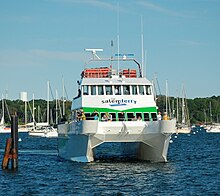Multihull
[13] The vertical clearance between the design waterplane and the bottom of the bridge deck determines the likelihood of contact with waves.[14] A trimaran (or double-outrigger) is a vessel with two outrigger floats attached on either side of a main hull by a crossbeam, wing, or other form of superstructure.[15] The word trimaran is a portmanteau of tri and (cata)maran,[16] a term that is thought to have been coined by Victor Tchetchet, a pioneering modern multihull designer, born in Ukraine (at that time part of the Russian Empire).[20] In 2018 a Swiss entrepreneur sought funding[21] to build a sail-driven quadrimaran called Manta that would use solar power to scoop plastic from the ocean.[23] A French manufacturer, Tera-4, produces motor quadrimarans which use aerodynamic lift between the four hulls to promote planing and reduce power consumption.[25][26] BMT Group, a shipbuilding and engineering company in the UK, has proposed a fast cargo ship and a yacht using this kind of hull.[29] While SWATHs are stable in rough seas, they have the drawbacks, compared with other catamarans, of having a deeper draft, being more sensitive to loading, and requiring more power because of their higher underwater surface areas.Vessels with slim hulls (typically multihulls) will normally create no appreciable bow wave to limit their progress.This started with the victory of the trimaran Olympus Photo, skippered by Mike Birch in the first Route du Rhum.[citation needed] The increasing popularity of catamaran since the 1960s is down to the added space, speed, shallow draft, and lack of heeling underway.






monohullcatamaranstrimaransOutrigger boatCatamaranSingle-outrigger boatsAustronesian peoplesAustronesian Expansionmaritime Southeast AsiaMicronesiaIsland MelanesiaMadagascarPolynesiaOceaniaEast AfricanSouth AsiaArchimedesSyracusiaPtolemy IV PhilopatorTessarakonteresJames WharramDerek KelsallTom LackLock CrowtherArthur PiverChris WhiteIan FarrierDick NewickSakmanWa (watercraft)WoleaiNational Museum of Ethnology (Japan)single-outrigger canoeHobie CatseaworthinessTrimaranPolynesianVictor TchetchetUkraineRussian EmpireRV TritonIndependencelittoral combat shipsBMT Groupcargo shipsmall waterplane area twin hullAmaryllisyacht racingOlympus PhotoRoute du RhumMassachusettsList of multihullsInternational C-Class Catamaran ChampionshipInternational Catamaran Challenge TrophyMonocatRound TexelSailingTurtlingTrampoline (multihulls)AthenaeusC. D. YongeHenry G. BohnWharramCatalacacceleration due to gravitywave making resistanceYachtingGavin le SueurWayback MachineAustronesian shipsTaiwanKavalanIpanitikaTataraIslandSoutheast AsiaBruneiBangkongPenjajapTongkangIndonesiaBantingBenawaBorobudur shipCerucuhChialoupGhurabGolekanJanggolanJelloreJongkongJuangaJukungJukung tambanganKalulisKelulusKnabat bogoluKora koraKotta maraK'un-lun poLancangLancaranLepa-LepaLeti letiLis-alisMalangbangMayangOrembaiPadewakangPaduwangPajalaPaledangPatoraniPelangPencalangPerahuPinisiPalariSampanSampan panjangSandeqMalaysiaBuggohPerahu payangPhilippinesArmadahanBalación